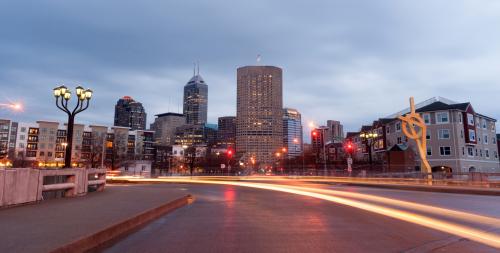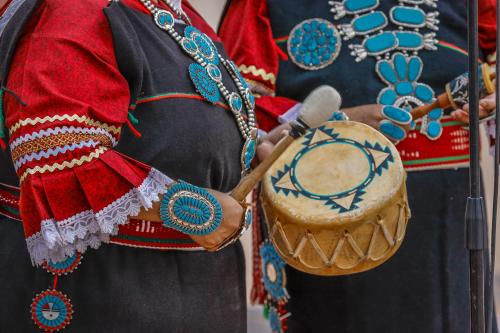Since 2016, when three Midwestern states (Michigan, Pennsylvania, and Wisconsin) proved decisive in President Donald Trump’s narrow electoral college victory, we here in the Midwest—along with many outside observers—have continued to sift the politico-economic tea leaves for signs of what motivates Midwestern voters.
Of particular interest is the degree to which these voters—specifically those in communities facing long-term economic challenges—exercised a sort of “anti-system” backlash vote in favor of candidate Trump, a theme I first explored in the wake of the 2016 election. On that count, last fall’s midterm elections, as well as statewide races in the Midwest, provide some evidence that a vibrant and growing local economy is a potential antidote to political appeals based on economic nostalgia and nativism; while continued economic decline may still excite responses in the other direction.
In November 2018, 15 congressional districts in the states of the Upper Midwest flipped from Republican red to Democratic blue. These were principally suburban and exurban counties within the orbit of thriving major metro areas like Minneapolis, Chicago, and Pittsburgh. Less noticed was that three Upper Midwest districts flipped the other way, from blue to red—Minnesota’s 8th district in the northern Iron Range; its 1st district in the south, bordering Iowa; and Pennsylvania’s 14th district encompassing counties in the southwest corner of that state.
In districts that flipped to Democrats, the party was aided by a large turnout of their base in African-American and progressive communities, as well as among young voters, women, and independents eager to cast an “anti-Trump” vote. But as the color coding in Table 1 suggests, in the 12 congressional districts that flipped to the Democrats, people were also doing better. In all of the congressional districts that went newly blue (save one in Iowa, and two in Pennsylvania where redrawn districts were a major contributor to party change), residents had incomes higher than statewide medians, as well as higher educational attainment—in most places by considerable margins. Conversely, in the three districts that moved from blue to red, incomes and educational attainment tended to lag statewide figures.

At the state level in November, voters in Michigan and Wisconsin replaced Republican governors with Democrats, while those in Pennsylvania re-elected a Democratic governor. Beyond increased turnout, these gubernatorial wins also seem to have been propelled by a changing and economically better-off electorate in historically conservative parts of these states.
Michigan provides a particularly notable example of these dynamics. Governor Gretchen Whitmer built her victory on more than the traditional Detroit and labor-heavy eastern Michigan vote. She achieved new-for-a-Democrat wins in Kent County (home to Grand Rapids, Michigan’s second city), eight other counties Donald Trump won in 2016, and almost-wins in other historic conservative strongholds that were seeing growing and changing populations. As the Oakland Press reported:
For years, even losing GOP candidates for statewide office still fared well in Kent County, which includes the Democratic stronghold of Grand Rapids but is surrounded by largely Republican-friendly turf. Whitmer is the first Democratic gubernatorial nominee to take the county since James Blanchard in 1986, and he was an incumbent. She almost defeated Republican Bill Schuette in historically Republican Grand Traverse County, home to Traverse City. And she gained in the state’s most conservative county, Ottawa, which includes Lake Michigan coastal communities. Perhaps not coincidentally, all three counties are among Michigan’s fastest-growing….
These voting patterns suggest that newfound economic vitality and changing demographics work hand-in-hand: Support for minorities and a diverse polity naturally builds as the economy changes, and more people feel optimistic about the future for themselves, their families, and their communities. The fact that the newly elected governors are relatively moderate Democrats, who did not run “anti-Trump” campaigns but spoke straightforwardly to issues of health care, education and infrastructure (Whitmer’s signature campaign slogan was “Fix the Damn Roads”), may buoy those recommending a “speak to the middle” lunch-bucket strategy for the party.
Of course, economic evolution in many of the Midwest’s small and medium-sized industrial cities—which can be viewed as both an economic and political priority—won’t happen overnight. But until then, experts suggest, the winning political path for Democrats in key Midwest states appears to be one of “both-and.” As political observer Ruy Texeira observed in the Washington Post: “Carry white college graduates, strongly mobilize nonwhite voters, particularly blacks, and hold deficits among white non-college-educated voters in the range of 10 to 15 points. Unlike Hillary Clinton in 2016…Democrats in Pennsylvania, Michigan, Wisconsin and Minnesota got all three parts of the formula right in the midterms.
As both parties approach the Midwest in 2020, November’s results suggest that candidates equipped to discuss new economic opportunity will be best positioned to capture the attention of—and votes in—the many rapidly evolving parts of this vast region.
University of Michigan’s Jack Farrell contributed to this post.
The Brookings Institution is committed to quality, independence, and impact.
We are supported by a diverse array of funders. In line with our values and policies, each Brookings publication represents the sole views of its author(s).







Commentary
Midterms showed that Midwestern economic performance could decide 2020 race
January 22, 2019